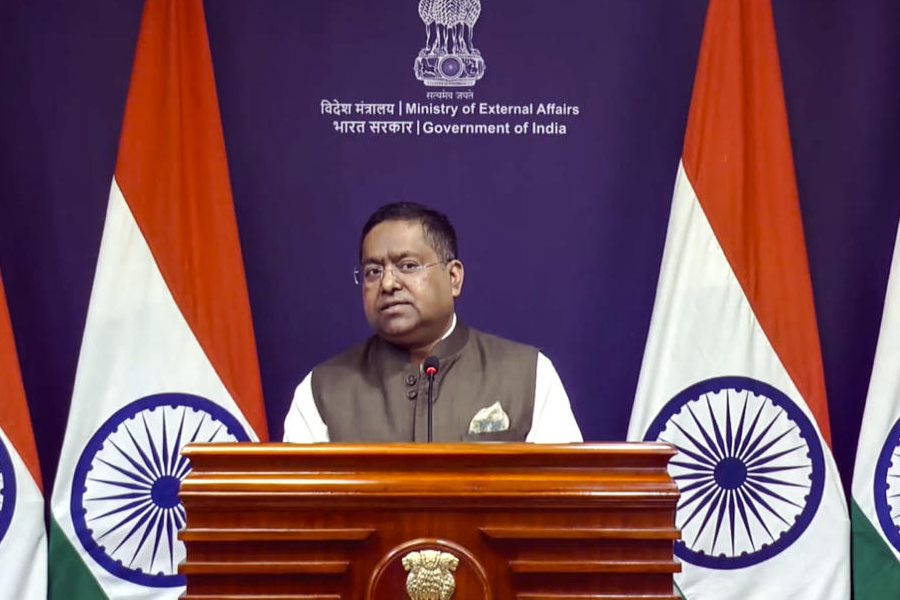The festive season is just round the corner. Look up at clear blue skies, soak in the fragrance of the shiuli concealed in the half darkness of dawn, catch fleeting glances of the kash phul — and you’ll know that the celebrations are not afar. For, these are the sights, the sounds and fragrances that trigger nostalgia — of seasons long gone, for celebrations in a bygone time, and faded memories poised to slip away forever.
Food is one thing that helps build memories. And today’s microwave generation has lost much of that. Pre-packaged TV dinners and takeaways don’t really leave much room for remembrance, do they?
Yet some of the nostalgia survives — in old cookbooks, in faded handwritten notes scribbled on shreds of paper now tucked away in a dresser and in grandma’s recipes, handed down the generations — perhaps now ready to slip away.
We bring you a few old Bengali recipes from some of the households in town that pride themselves on preserving their heritage. Most of them host a Durga Puja (each unique in its own way). And it is the tradition of the Puja bhog that has helped them preserve some unusual recipes. Here’s looking at some dishes that have stood the test of time and are sure to keep your kitchen fragrant with their aromas.
Chhatubabu Latubabur Bari
The Chhatubabu Latu-babu residence is a large, imposing mansion on Beadon Street, which evokes a distinct sense of yearning for the years gone by. The Deb family’s Puja dates back to 1780. From saptami to dashami, the bhog of luchi and fried vegetables is served at the residence to all guests, along with monda, kheer, rosogolla, sandesh and doi.
On ashtami, sandhi puja begins with the priest offering 108 lotuses to the goddess within a circle of 108 silver pradips. A unique characteristic of this Puja is that instead of Lakshmi and Saraswati, Jaya and Bijaya accompany the Goddess. On the right hand stands Mahadev, while Ramchandra stands on the left. With footfalls touching some hundreds during the Puja days, the women of the family leave the bhog to the karigars hired for cooking. But the family continues to hold on to its traditional recipes, some of which were shared with us by Latika Deb, a member of the Deb family.
 |
Aakhnir joler niramish pulao
Ingredients:
- 2 cups Basmati rice
- 3tbs ghee
- 4 large potatoes, peeled and cut in half (optional)
- 250gm chhana (optional) 1/2 cup peas (optional)
- 1 cup cauliflower, cut into florets (optional)
- 2tbs cashew nuts 1tbs raisins Salt to taste
For the aakhnir jol:
- 1in ginger
- 2 cinnamon sticks
- 4tsp garam masala (whole)
- 1tsp shah jeera
- 1tsp shah marich
- 2 bay leaves A few cardamoms
- 1 javitri
method:
This pulao is a family favourite and potatoes, cauliflower, peas or even home-made chhana (not paneer) fried in ghee are used to garnish it. Wash and dry the Basmati rice. Keep aside. Boil the potatoes or other vegetables and fry in ghee. Keep aside. If you want to make it with chhana then take the chhana and press it to let the excess water run off. Cut into small pieces and fry in ghee. Keep aside. For the aakhnir jol, take ginger, garam masala, bay leaves, cinnamon sticks, shah jeera, javitri, shah marich, cardamoms and boil in water till the liquid reduces. Sauté the dried rice with garam masala, bay leaves, and the other spices in ghee and add the aakhnir jol. When it’s almost done, add the vegetables or chhana. Garnish with cashews and raisins.
Darjipara Mitra Bari
The Durga Puja of the Mitras dates back to 1806 and is conducted with as much fervour and devotion even today. All members of the household, across generations, prepare for the Puja themselves — from adorning the gods to jogar or the arrangements for the Puja. Instead of lotus, 108 aparajita flowers are offered to the goddess during sandhi puja. The women of the house meticulously prepare the naibedya or the edibles offered to the gods.
Naibedya prepared in butter is a speciality of the Mitra family. Different kinds of pickles are also offered to the goddess including kul, tamarind, sweet mango and aamsi (dried mango) pickles. They also prepare a bori naibedya of various kinds of dal and poppy seeds.
Dhanebata diye muger dal was a recipe introduced by Shashimukhi Mitra into the family’s repertoire some five generations ago. An expert in the kitchen, Mitra used her culinary skills to add new twists to old delicacies.
 |
Muger dal dhonebata diye
Ingredients:
- 200-250gm of sona moong dal
- 1 cup shelled peas ½ cup cauliflower florets
- 1 cup potato cubes
- 1tbs ginger paste
- 1tsp cumin seeds
- 5 green cardamoms
- 4 green chillies
- 2 tomatoes Salt and sugar to taste
- ½ cup milk 2tbs coriander paste
- 2tsp turmeric powder
- 1-2 dry red chillies
- 4tbs ghee
method:
Roast the sona moong dal till it turns reddish. Boil the dal with peas, cauliflower, potato cubes, cardamoms and green chillies. Heat ghee in a pan and add cumin seeds. Add tomato cubes and stir-fry a little. Add the dal with all the vegetables to it. Add salt, turmeric powder and a little sugar and mix well. Take the milk and mix the coriander paste with it. When the dal is almost ready, pour the milk into it and mix well. Boil for three minutes. Add a couple of dry red chillies (optional). Sprinkle some ghee on it and serve hot.
Pathuriaghata Ghosh Bari
The techala Durga Puja of Pathuriaghata is about 163 years old and is one of the oldest Pujas amongst the old aristocratic families of Calcutta. A unique feature of this Puja is the ablution of the Naba Patrika in the house, instead of in the Ganges as is the usual practice. Apart from the customary bhog, the tradition of offering homemade sweets to the goddess still continues enthusiastically. The women of the house prepare delicacies like chandrapuli, khirer chhapa and of course, narkol naru to welcome the goddess.
Chine Kabab was a delicacy taught to Smriti Mitra — the sister of the present head of the family, Pradip Ghosh — by her mother-in-law.
 |
Chingrimachher Chine Kabab
Ingredients:
- 4 big lobsters
- 3tbs ghee
- 2tbs ginger garlic paste
- 2tbs onion paste
- 1tbs garam masala powder
- Salt and sugar to taste
method:
Take four large lobsters and boil them. De-shell them and keep the shells aside. Grind the flesh into a fine paste. Heat ghee in a pan. Add the flesh and stir-fry for 3-4 minutes. Add onion paste and ginger-garlic paste. Season with garam masala, salt and a little sugar. Stir well. When it is ready, put the filling into the lobster shells and fry lightly in ghee. Serve hot.
Sovabazar Rajbari
Maharaja Nabakrishna Deb flagged off this now famous Durga Puja in the year 1757, with a Puranic style of worship where the Goddess is appeased not with the sacrifice of animals but vegetables. On navami though, a fish is sacrificed to make up for the vegetarian fare. The family however hasn’t gone veggie with a vengeance.
This palate-tingling mutton dish, for example, was prepared by Probal Narayan Deb’s grandmother, the late Labonyolata Deb. Probal’s mother, the late Reba Deb also cooked Labonyolata’s signature dish but never quite matched up to her mother-in-law’s formidable standards. To keep the tradition going, Probal cooks it on special occasions as well.
 |
Mete chochchori
Ingredients:
- 600-700gm of mutton liver chunk
- 500gm potato diced and brushed with salt
- 100gm onion paste
- 300gm chopped onion
- 5/6 sliced cloves of garlic
- 1 or 2 bay leaves
- 1½tbs ginger paste
- 1 tomato (puréed)
- ½tsp turmeric powder
- 2tsp red chilli powder
- Sugar to taste
method:
Boil 1½ litres of water and add salt and turmeric. Dip the chunk of mutton liver in it at low heat, for half a minute. The liver must remain tender from within but slightly hard on the outside. After it cools, cut the liver into 1½ inch cubes and set aside. Heat oil in a heavy bottomed pan and fry the potatoes till they turn brown. Set aside. Put bay leaves, chopped onion and garlic in the pan and fry till golden brown. Add turmeric, red chilli powder, tomato paste and ginger paste and sauté till the oil separates. Add the fried potatoes, liver cubes, salt and sugar and stir well. Cook on a slow fire till done. Serve hot.
Jagatjanani Bari
The temple to Jagatjanani or Basanti Durga was built by the Shaw family way back in 1871. The ashtadhatu goddess has been worshipped daily in an elaborate ritual ever since. Basanti Puja is traditionally observed in spring and this is when the main Puja is celebrated. Annabhog or cooked rice is not offered to the goddess — instead the bhog consists of luchi cooked on wood fire, fruits and sweets. Homemade narkol naru, tilkuto, roshkora and murki are also part of the divine spread.
Payesh is an integral part of the Bengali food culture but ever tasted one that can be sliced and eaten as a cake? The Shaw family has the recipe that has been handed down the generations but whose origins are now forgotten. They call it paansh.
 |
Paansh
Ingredients:
- 1.5 litres milk
- 300gm Gobindobhog rice
- 250gm sugar
- 1 grated coconut
- 200gm kheer (condensed milk)
method:
Take the milk in a pan and bring to a boil. Wash the rice and add to the milk. Stir occasionally. Add the sugar. Cook till the rice is ready. When the mixture thickens, add the grated coconut. Mix well. Pour the kheer into the mixture and fold it in. When it begins to bubble, pour the paansh into a tray and let it cool. Cut into slices and serve.
Sabarna Roy Choudhuryr Bari
This Durga Puja dates back to 1610. The Puja is still conducted with a lot of aplomb at the Barisha residence of these former zamindars but some of the rituals (and recipes) belonging to the bygone era are now lost. Devarshi Roy Choudhury, who belongs to the 35th generation of the Roy Choudhurys, delved into the history of the family’s near-forgotten recipes to find a particularly sweet one for us.
Devarshi first tasted the scrumptious pranmohini at the table of his thakuma Bharati Roy Choudhury. She was an expert chef and gourmet who learnt the recipe from her mother-in-law, Kamalini Debi. Handed down the generations, this recipe dates back to 1850, when the women of the household used to cook it quite regularly and serve it on silverware to the Goddess and to the family’s guests.
Sabarno Pranmohini
 |
Ingredients:
- 6 pointed gourds (parwal)
- 2tsp ghee
- 500ml milk
- 25gm raisins
- 25gm crushed cashew nuts
- 150gm khoya 10gm saffron
- A dash of rose water
- For the sugar syrup: 500gm sugar
method:
For the sugar syrup, boil the sugar in two cups of water till it thickens. Keep aside. Boil the milk over low fire to prepare the kheer. For the filling, grind the khoya, raisins, cashew nuts and saffron together. Fry it in ghee and keep aside. Scoop out the insides of the parwal and stuff it with the filling. Make tiny holes in the parwal and boil for 20-25 minutes in the sugar syrup. Serve with kheer on top.
Palate pleasers
Two common recipes — part of every elaborate Bengali meal are dhnokar dalna and chhanar kalia. But we tend to cook the simplified versions.
Latika Deb of the Chhatubabu Latubabu family gave us different takes on these two age-old favourites. One involves using peas or koraishuti to make the dhnoka while the other makes the chhanar kalia with matar dal stuffing. As a young new bride of 18, these were part of the first meal she cooked for her in-laws.
 |
Koraishutir dhnoka
Ingredients:
- 1 cup matar dal
- 3 cups of shelled peas A pinch of asafoetida
- 1tsp kalo jeera
- 1tsp fennel (mouri)
- 2tbs ginger paste Salt and sugar to taste
- 1tsp turmeric powder
- 1tbs garam masala
- 3 large diced tomatoes
- 4tbs ghee
method:
Soak the dal overnight before grinding it. Grind the green peas into a fine paste. Mix the two together with asafoetida, kalo jeera, fennel, ginger paste and sauté in ghee. When it dries add the salt and sugar. Put the mixture on a flat oiled tray. Press it down and when it cools down cut into squares. Make the gravy with asafoetida, garam masala, tomatoes, turmeric and salt and bring to a boil. When it thickens, pour it over the dhnoka.
_______________________________
 |
Chhanar devil
Ingredients:
- 500gm chhana
- 250gm chholar dal
- A pinch of asafoetida or hing
- 4tbs ghee
- 2tbs ginger paste
- 1tsp kalo jeera
- Salt and sugar to taste
- 2tbs garam masala powder
- 1tbs jeera powder
- 1tsp turmeric
- 3 large tomatoes
method:
Grind the homemade chhana finely. Soak chholar dal overnight and grind to a fine paste with hing, and sauté it in ghee with ginger paste, kalo jeera, salt and sugar to taste. When the mix cools, add the garam masala powder and jeera powder. Make a thin shell out of the ground chhana and stuff the dal mixture into the shells. Fry in ghee. Make a gravy with the ginger paste, hing, garam masala, turmeric, tomato, salt and sugar. When the gravy comes to a boil, put the stuffed chhana in it.
Compiled by Nandini Guha, Suktara Ghosh, Anindita Mitra, Tania Bhattacharya;
Photographs by Rashbehari Das, Subhendu Chaki










